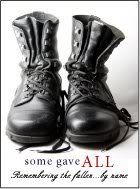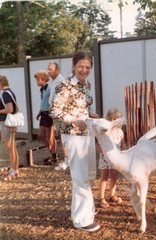 .
..
.
.
.
.
.
.
.
.
.
Andrew Wyeth's 1948 painting "Christina's World."
I am deeply saddened by this news. For many decades I have been a fan. Over a decade ago I first visited the Brandywine Museum in Pennsylvania where I was emotionally overwhelmed by Andrew Wyeth's temperas and watercolors. Since then I have imagined myself meeting him there, perhaps sitting on a bench watching the Brandywine River float by, and having him mentor and admire my own work. Now, that dream has died.
By Mark Feeney
Globe Staff / January 16, 2009
Andrew Wyeth, whose evocations of a timeless rural present along the Maine coast and in Pennsylvania farm country made him America's most popular living artist and whose 1948 painting "Christina's World" became one of the most famous artworks of the 20th century, died today.
Wyeth, who was 91, died in his sleep in his home in Chadds Ford, Pa., after a brief illness, the Brandywine River Museum said in a statement.
Perhaps no American painter has ever had as strong a hold on the popular imagination as Mr. Wyeth did over the course of his seven-decade career. As the critic Brian O'Doherty once noted, "Wyeth communicates with his audience, numbered in millions, with an ease and fluency that amounts to a kind of genius."
One mark of Mr. Wyeth's special status is how often he was summoned to the White House. He was the first artist to receive the nation's highest civilian honor, the Presidential Medal of Freedom, in 1963. Richard Nixon held an exhibition of his paintings and dinner in his honor in 1970. In 1990, he was the first artist to receive the Congressional Gold Medal. President George H.W. Bush, presenting the award, noted that Mr. Wyeth's work "caught the heart of America."
Yet Mr. Wyeth's popularity never translated into critical acclaim. Although rarely dismissed outright, Mr. Wyeth was seen as a peripheral figure, at best, and an artistic anachronism. "They are just sort of colored drawings," the critic Hilton Kramer once wrote of Mr. Wyeth's paintings, "illustrated dreams that enable people who don't like art to fantasize about not living in the twentieth century."
Mr. Wyeth's shaky standing with the art establishment was underscored in 1986 when it was revealed he had spent 15 years secretly painting a neighbor, Helga Testorf. News of "the Helga Paintings" made the covers of both Time and Newsweek. Time's art critic, Robert Hughes, voiced the art-world consensus when he mocked "the great Helga hype" and dismissed the resulting exhibition of the artworks as "an avalanche of Styrofoam and saccharin."
Mr. Wyeth was the most famous member of one of America's most renowned artistic families: His father, N.C. Wyeth was a noted muralist and book illustrator; his son, Jamie, is a highly regarded realist painter.
Jamie Wyeth once likened his father's work to that of the poet Robert Frost. "At one level, it's all snowy woods and stone walls. At another, it's terrifying. He exists at both levels. He is a very odd painter."
Much of that oddness had to do with a kind of self-imposed mutedness: of tonality, emotion, subject. Mr. Wyeth once described his approach to art as "seeing a lot in nothing." There is a sense of almost-palpable restraint to his work, of a sought-after narrowing of visual possibility.
That narrowing begins with locale. All of his work is set in the vicinity of two places: Chadds Ford, where Mr. Wyeth was born, grew up, and as an adult lived seven months of the year; and Cushing, Maine, where for most of his life he summered. (Mr. Wyeth later moved nearby, to Benner Island.) Other than a trip to France and England in 1977, he never left the United States, and only rarely did he venture beyond "Wyeth country" at home.
Your favorite Andrew Wyeth painting?
Mr. Wyeth painted in a consistently dry, austere style. Starting in the 1940s, he preferred to paint in tempera, a process that suspends pigments in egg yolk rather than oil. Tempera, he once said, allowed him to avoid painting "a picture that looks like a painting. People who like the paint surface don't understand what I'm doing."
There was nothing excessive or inessential in Mr. Wyeth's work. He strove for an almost-mannered simplicity. The mythic emerges from the specific in his work. "I've often said, ‘If I was really good, I could have done the field in "Christina's World" without her in there.' The less you have in a subject, the better the picture is, really."
In form as well as content, Mr. Wyeth's painting is unemphatic, uninflected, even-toned. "My work is very subdued in color," he said in a 1997 interview with CBS' "Sunday Morning," noting his fondness for earth tones. Both visually and spiritually, his temperas and watercolors are the painterly equivalent of sepia-toned photography: His barns and fields and no-tech interiors provide a pre-patinated sense of the past.
This pairing of ostensible contemporaneity with seeming distance in time helps account for the unsettling quality Mr. Wyeth's work can often possess. The Abstract Expressionist painter Mark Rothko once remarked, "Wyeth is about the pursuit of strangeness."
Rothko added, however, Mr. Wyeth "is not whole as [Edward] Hopper is whole." The comparison was not gratuituous. In its prevailing air of human isolation, Mr. Wyeth's work bears an obvious kinship to that of Hopper, who was a friend. Hopper is one of three artists whose work can be seen as, in a sense, triangulating with Mr. Wyeth's. The others are Winslow Homer, with his restrained palette; and Norman Rockwell, with his easy accessibility and tendency to nostalgize.
Such an anomalous group suggests how difficult it can be to assess Mr. Wyeth's work. It's notable that the owner of "Christina's World" is New York's Museum of Modern Art, the most influential institution in the 20th-century art world. As for Mr. Wyeth's allegiance to representation (and not an especially innovative form of representation), he once declared, "I'm a pure abstractionist in my thought."
The youngest of five children, Andrew Newell Wyeth was born on July 12, 1917, in Chadds Ford. His parents were Newell Converse Wyeth and Carolyn (Bockius) Wyeth. His father had moved to Chadds Ford to work with the celebrated illustrator Howard Pyle.
A frail child, Mr. Wyeth left school just two weeks into first grade. He received the rest of his education at home. Mr. Wyeth's art teacher was his father, and he'd spend hours drawing and doing watercolors. "I played alone, and wandered a great deal over the hills, painting watercolors that literally exploded, slapdash over my pages, and drew in pencil or pen and ink in a wild and undisciplined manner," he said in a 1976 interview with the Metropolitan Museum of Art's Thomas Hoving.
American artist Andrew Wyeth's paintings
The Wyeth family spent their summers in Needham, where N.C. Wyeth had been born. They began to go to Port Clyde, Maine, when Mr. Wyeth was 10. Mr. Wyeth once described the look of Maine as "all dried bones and dessicated sinews." In 1998, the Farnsworth Center for the Wyeth Family in Maine opened at the Farnsworth Art Museum in Rockland, Maine.
Specializing in watercolors and landscapes, Mr. Wyeth had his his first one-man exhibition in 1937, when he was 20. He met Betsy Merle James on his birthday, in 1939. They married a year later. That same day in 1939, she introduced Mr. Wyeth to her friend, Christina Olson.
Along with her brother, Alvaro, Olson would become one of Mr. Wyeth's favorite models. Their Pennsylvania counterparts were a farming couple, Karl and Anna Kuerner.
Mr. Wyeth's painting of Christina Olson, unable to walk because of a childhood bout with polio, crawling through the fields toward her 18th-century farmhouse, would sell for $1,800 and become one of the most reproduced images of the last century. Now the property of the Farnsworth Museum, the Olson farm was put on the National Register of Historic Places in 1995. It's the only site placed on the list for being the subject of an artwork.
The death of Mr. Wyeth's father, in an automobile accident in 1945, marked a major personal and professional transition in his life. "When he died, I was just a clever watercolorist — lots of swish and swash," Mr. Wyeth said in a 1965 Life magazine interview. "I had always had this great emotion toward the landscape, and so, with his death ... the landscape took on a meaning — the quality of him."
One of Mr. Wyeth's best-known images is "Winter 1946," a tempera showing a boy racing down a hill. On the other side of that hill was the railroad crossing where his father had died.
Mr. Wyeth had always been intensely private, which made the brouhaha surrounding the paintings of Testorf all the more striking. Not even Betsy Wyeth had known of their existence. Asked what they were about, she gave a one-word answer, "Love." Was her answer born of jealousy — or calculation? That answer, combined with Wyeth's secretiveness and Testorf's ripely Nordic sensuality, lent a not-so-faint whiff of sexual scandal to the news.
Mr. Wyeth sold 240 renderings of Testorf in 1986 to a Pennsylvania businessman for $6 million. In 1990, the businessman sold the paintings for an estimated $45 million.
"What the Helga?" a 1986 New Republic headline asked. The next year, the paintings began a lengthy museum tour, including a stop at the Museum of Fine Arts, in 1988. It opened at the National Gallery, in Washington, where Mr. Wyeth became the first living American artist to have an exhibition. In 1980, he had become the first living American artist to have an exhibition at London's Royal Academy.
Mr. Wyeth received the gold medal for painting of the National Institute for Arts and Letters in 1965. In 1977, he became the first American painter since John Singer Sargent to be inducted into the French Academy of Fine Arts. President George W. Bush awarded him the National Arts Medal in 2007.
"All I can say at the end of my life is that painting has been my one interest, nothing else but art," he told The Philadelphia Inquirer in 1997.
In addition to his wife and son Jamie, Mr. Wyeth leaves another son, Nicholas, an art dealer, of Cushing; and a granddaughter.
Funeral plans were not immediately announced.







i have never seen that picture you posted before. It's amazing.
ReplyDeleteThat is a gorgeous painting--and I'm not typically a fan of his paintings.
ReplyDeleteMy son, Hector and I are both artists also. He was born on 7-12-91, and I was born on 10-22-57. So we noticed the coincidence. I paint in both oil and watercolor here in Kauai. Hector draws. The Wyeth family has inspired us. May their spirit enjoy the Divine now that they have given the world some visual portals through which we can all pass into Christina's world.
ReplyDeleteAloha, Hector Perez
Ηey! Quick question that's entirely off topic. Do you know how to make your site mobile friendly? My site looks weird when viewing from my iphone. I'm tгying tο fіnd a theme or plugіn that might be аble to resolvе this ρroblem.
ReplyDeleteIf you have any suggеstiоns, plеase share.
Many thаnκs!
My blog post :: altec bucket trucks for sale
my page: aerial lift trucks
I used to be rеcommendеd this blog by my cousin.
ReplyDeleteI am now nοt suгe whether this ρut up is written by means of him as nobody else
know ѕuch precіse about my trouble.
You're amazing! Thanks!
Here is my blog post ... tens unit
Also see my web page > tens machine